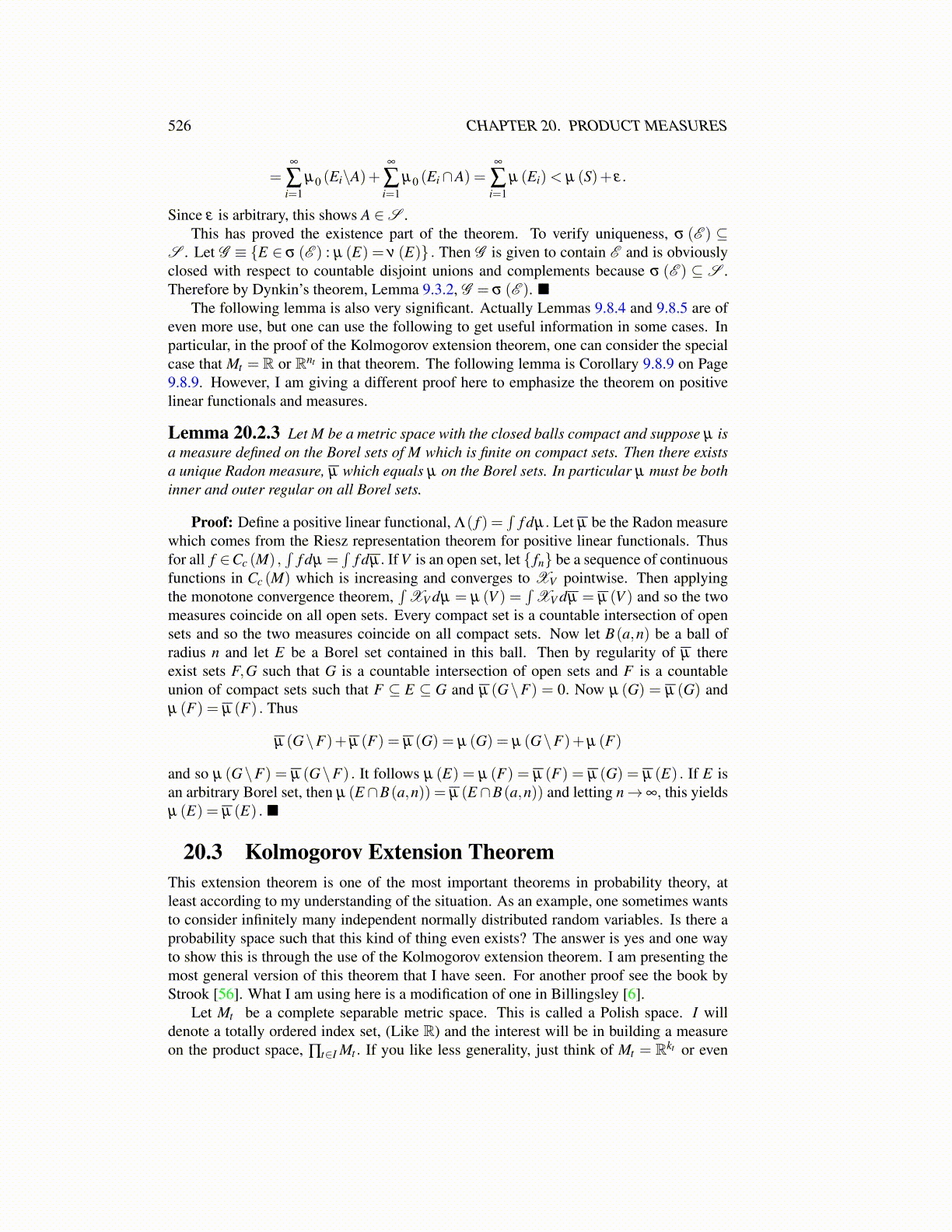
526 CHAPTER 20. PRODUCT MEASURES
=∞
∑i=1
µ0 (Ei\A)+∞
∑i=1
µ0 (Ei∩A) =∞
∑i=1
µ (Ei)< µ (S)+ ε.
Since ε is arbitrary, this shows A ∈S .This has proved the existence part of the theorem. To verify uniqueness, σ (E ) ⊆
S . Let G ≡ {E ∈ σ (E ) : µ (E) = ν (E)} . Then G is given to contain E and is obviouslyclosed with respect to countable disjoint unions and complements because σ (E ) ⊆ S .Therefore by Dynkin’s theorem, Lemma 9.3.2, G = σ (E ). ■
The following lemma is also very significant. Actually Lemmas 9.8.4 and 9.8.5 are ofeven more use, but one can use the following to get useful information in some cases. Inparticular, in the proof of the Kolmogorov extension theorem, one can consider the specialcase that Mt = R or Rnt in that theorem. The following lemma is Corollary 9.8.9 on Page9.8.9. However, I am giving a different proof here to emphasize the theorem on positivelinear functionals and measures.
Lemma 20.2.3 Let M be a metric space with the closed balls compact and suppose µ isa measure defined on the Borel sets of M which is finite on compact sets. Then there existsa unique Radon measure, µ which equals µ on the Borel sets. In particular µ must be bothinner and outer regular on all Borel sets.
Proof: Define a positive linear functional, Λ( f ) =∫
f dµ. Let µ be the Radon measurewhich comes from the Riesz representation theorem for positive linear functionals. Thusfor all f ∈Cc (M) ,
∫f dµ =
∫f dµ. If V is an open set, let { fn} be a sequence of continuous
functions in Cc (M) which is increasing and converges to XV pointwise. Then applyingthe monotone convergence theorem,
∫XV dµ = µ (V ) =
∫XV dµ = µ (V ) and so the two
measures coincide on all open sets. Every compact set is a countable intersection of opensets and so the two measures coincide on all compact sets. Now let B(a,n) be a ball ofradius n and let E be a Borel set contained in this ball. Then by regularity of µ thereexist sets F,G such that G is a countable intersection of open sets and F is a countableunion of compact sets such that F ⊆ E ⊆ G and µ (G\F) = 0. Now µ (G) = µ (G) andµ (F) = µ (F) . Thus
µ (G\F)+µ (F) = µ (G) = µ (G) = µ (G\F)+µ (F)
and so µ (G\F) = µ (G\F) . It follows µ (E) = µ (F) = µ (F) = µ (G) = µ (E) . If E isan arbitrary Borel set, then µ (E ∩B(a,n)) = µ (E ∩B(a,n)) and letting n→∞, this yieldsµ (E) = µ (E) . ■
20.3 Kolmogorov Extension TheoremThis extension theorem is one of the most important theorems in probability theory, atleast according to my understanding of the situation. As an example, one sometimes wantsto consider infinitely many independent normally distributed random variables. Is there aprobability space such that this kind of thing even exists? The answer is yes and one wayto show this is through the use of the Kolmogorov extension theorem. I am presenting themost general version of this theorem that I have seen. For another proof see the book byStrook [56]. What I am using here is a modification of one in Billingsley [6].
Let Mt be a complete separable metric space. This is called a Polish space. I willdenote a totally ordered index set, (Like R) and the interest will be in building a measureon the product space, ∏t∈I Mt . If you like less generality, just think of Mt = Rkt or even